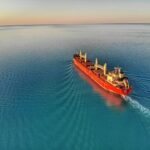The Role of Kelp Forests in Marine Ecosystems: Benefits and Conservation

Let’s explore an underwater metropolis thriving, not with steel and glass, but with towering fronds of seaweed dancing in the ocean currents. This is the world of kelp forests, vibrant ecosystems essential to the health of our planet. Think of them as the emerald cities of the seas, teeming with life and providing invaluable benefits that ripple outwards, touching even your plate.
Life in the Kelp Kingdom: Where Whispers Turn to Roars
What is a kelp forest? It’s the towering kelp fronds swaying in rhythmic dance, their graceful movements mesmerising even the most seasoned diver. This is no ordinary park; it’s a metropolis bustling with lifeforms as diverse as they are fascinating.
Playful sea otters can be seen using the kelp like jungle gyms, their thick fur catching the sunlight like shimmering diamonds. Their playful dives and cheeky grins remind you that this hidden city thrives with joy and energy. Look closely, and you might spot a shy seahorse clinging to a frond, its intricate camouflage perfectly blending it with the swaying leaves. It’s a master of disguise in this underwater masquerade ball.
Sunlight peeks through the canopy, creating dappled patterns on the sandy seabed where lobsters scuttle, their antennae twitching like sensitive radars. These underwater landlords diligently maintain their burrows, guarding their territory with watchful eyes. Above them, schools of fish flit and dart, their scales glimmering like liquid silver coins. Imagine rockfish weaving between the fronds, their vibrant colours flashing like neon signs in this aquatic cityscape.
But the real stars of the show are the anemones clinging to the kelp like colorful decorations. These crimson giants are swaying gently, their tentacles moving rhythmically, capturing unsuspecting zooplankton. Look closer, and you might find tiny nudibranchs, their jewel-toned bodies adorned with elaborate frills, grazing on the anemones’ leftovers. It’s a symbiotic ballet, a testament to the intricate connections that sustain this underwater kingdom.
This is just a glimpse into the vibrant tapestry of life within a kelp forest. From the playful otters to the camouflaged seahorses, every creature plays a vital role in this underwater metropolis. It’s a symphony of colours, textures, and movements, a hidden world unlike any other on Earth.

Benefits Beyond the Waves: Kelp Forests – Nature’s Unsung Heroes
Beautiful kelp forests are swaying gently beneath the waves, their emerald embrace offering sanctuary to countless creatures. But their impact extends far beyond the vibrant world hidden beneath the surface. Kelp forests, these underwater metropolises, offer a plethora of benefits, silently touching our lives in remarkable ways.
Nature’s Champions against Climate Change
As CO2 emissions rise, kelp forests emerge as silent warriors in the fight against climate change. These underwater giants act as carbon sinks, absorbing vast amounts of CO2 from the atmosphere through photosynthesis. Each swaying frond is a tiny air purifier, working tirelessly to mitigate the effects of global warming. Research estimates that kelp forests store around 20 times more carbon per acre than terrestrial rainforests, making them invaluable allies in the battle for a sustainable future.
Cradle of Life, Provider of Bounty
The intricate maze of kelp blades offers shelter and food for these vulnerable young, their growth nurtured by the abundance of plankton attracted by the kelp’s photosynthetic dance. These fronds are the underwater kindergartens, nurturing the next generation of marine life that sustains coastal communities and provides food for millions around the world. Kelp forests act as critical spawning grounds for commercially valuable fish like cod, salmon, and tuna, their health directly impacting the livelihoods of fishing communities and the seafood you might enjoy on your plate.
Guardian of Coastlines
Kelp forests stand like silent sentinels, their dense fronds absorbing the energy of waves, reducing their impact on the coast. These underwater breakwaters protect communities from erosion, safeguarding homes and infrastructure from the destructive power of the ocean. In a world increasingly vulnerable to the effects of climate change, kelp forests act as natural coastal defenses, reminding us of the interconnectedness between the health of our oceans and the well-being of coastal communities.
Treasure Trove of Innovation
Beyond their ecological value, kelp forests hold immense potential for sustainable innovation. Researchers can extract alginate, a versatile biopolymer derived from kelp, and use it to create biodegradable packaging, textiles, and even medical applications. These renewable resources offer a glimpse into a future where innovation doesn’t come at the expense of our planet’s health. Furthermore, kelp is being explored as a potential source of biofuels, offering a glimpse into a sustainable energy future fueled by the very plants that safeguard our oceans.
Kelp forests are not just underwater wonders; they are vital components of our planet’s health and the well-being of our communities. From mitigating climate change to nurturing marine life, protecting coastlines, and inspiring sustainable innovation, these emerald metropolises silently offer a wealth of benefits that ripple outwards, touching our lives in surprising and significant ways. By recognising their intrinsic value and actively working towards their conservation, we ensure the continued prosperity of these underwater treasures and secure a brighter future for ourselves and generations to come.

A Shadow Looms Over the Emerald City: Threats to the Kelp Kingdoms
What if vibrant kelp forests are replaced by a barren wasteland? Sunlight will struggle to penetrate the murky water, revealing ghostly remnants of what once thrived. This heartbreaking scene is the chilling reality facing many kelp forests, victims of a complex web of threats that cast a long shadow over their emerald kingdoms.
Rising Temperatures, Shifting Tides
As the ocean’s temperature climbs, driven by rising CO2 emissions, kelp struggles to survive. Imagine these underwater giants, adapted to thrive in cooler waters, experiencing heat stress, weakening their defenses and making them susceptible to disease. This warming disrupts the delicate balance of the ecosystem, triggering domino effects throughout the food chain. Picture urchins, normally kept in check by predators, multiplying rapidly in the warmer water, grazing on kelp with insatiable appetites. These “barrens” created by overgrazing leave behind desolate landscapes, devoid of the once-teeming life.
Pollution’s Poisonous Touch
Toxic pollutants, agricultural runoff, and industrial waste are leaching into the ocean, infiltrating the delicate ecosystem of the kelp forest. These contaminants act like slow-acting poisons, disrupting the kelp’s growth and ability to reproduce. Vibrant fronds can become discoloured and weak, unable to withstand the added stress. This can have a huge impact on the myriad creatures that call the kelp forest home, many succumbing to the silent poisoning that permeates their underwater world.
Unsustainable Fishing, A Disharmonious Symphony
Fishing vessels often cast huge nets, indiscriminately harvesting not just target species but also kelp itself. This disrupts the delicate predator-prey balance, creating cascading consequences. Populations of kelp-eating fish, no longer controlled by their natural predators, will be exploding in number, further accelerating the decline of the kelp forest. This cycle of unsustainable fishing threatens not only the kelp itself but also the very fabric of this underwater metropolis, jeopardising the food security and livelihoods of coastal communities, relying on a healthy marine ecosystem.
The Cost of Inaction
Think about a world without kelp forests, the silence deafening where once vibrant life buzzed. Picture coastlines battered by waves, their natural defenses stripped away. The economic repercussions will be catastrophic as fisheries collapse, and communities lose their connection to the ocean’s bounty. This is not just a future to fear; it’s a stark reality we risk creating by ignoring the threats to these underwater emerald cities.
But amidst the looming shadow, there is hope. Conservation efforts are underway, seeking to restore damaged kelp forests, implement sustainable fishing practices, and reduce pollution. By recognising the value of kelp forests and actively working towards their conservation, we can ensure that these emerald kingdoms continue to thrive, safeguarding the health of our planet and securing a brighter future for all.
Hope From the Depths: Rescuing the Emerald Kingdoms
Champions of Kelp
There’s quite a lot that can be done to restore the kelp forests. Marine biologists can start planting kelp seedlings, nurturing them back to life with the same care a gardener tends to their prized blooms. Citizen scientists can monitor kelp populations, their data crucial for understanding the challenges and informing conservation strategies. Local communities can organise beach cleanups, removing plastic pollution that threatens to choke the life out of the kelp forests. These seemingly small actions, like ripples on the water, combine to create a wave of change, pushing back against the tide of threats.
Innovation Blooms
Cutting-edge technology is now widely used to heal the kelp forests. Underwater drones are surveying vast areas, mapping kelp health and identifying threats. Researchers are developing targeted solutions to combat urchin overgrazing, restoring balance to the ecosystem. Innovative aquaculture techniques allow to develop sustainable farming of kelp, meeting market demands while minimising pressure on wild populations. These solutions offer a glimpse into a future where technology and conservation work hand-in-hand, safeguarding the future of the kelp kingdoms.
Collaborative Spirit
Scientists, communities, and governments are coming together, recognising that the fate of kelp forests transcends borders and disciplines. International agreements are currently being forged, setting sustainable fishing quotas and strengthening pollution regulations. Local communities are also partnering with conservation organisations, their combined knowledge and resources fueling impactful restoration projects. This spirit of collaboration, where stakeholders unite under a common banner, is the cornerstone of successful conservation efforts, ensuring the long-term health of these vital ecosystems.
Inspiring Change
It’s crucial to understand the important role that emerald kelp kingdoms play in maintaining our planet’s health, and the importance of protecting them. This hope lies not just in restoring kelp forests, but in inspiring and empowering future generations to become stewards of the ocean, ensuring a sustainable future for both people and the planet.
Even small actions can make a difference. Through collective action, we can turn the tide against the threats, heal the emerald kingdoms, and ensure that their vibrant symphony continues to echo through the depths, for generations to come.
Facts and Statistics
Global Reach: Kelp forests exist in shallow coastal waters worldwide, spanning across all temperate oceans, including the Pacific, Atlantic, Indian, and Southern Oceans.
They cover an estimated 250,000 square kilometers globally, equivalent to the size of Great Britain.
Ecological Powerhouses: Kelp forests are among the most biodiverse ecosystems on Earth, sheltering over 8,000 species of plants and animals.
A single kelp plant can grow up to 18 inches per day, reaching lengths of over 150 feet, creating a complex underwater habitat.
Kelp forests absorb millions of tons of carbon dioxide from the atmosphere each year, playing a crucial role in mitigating climate change.
They filter pollutants from the water, improving water quality and supporting healthy marine ecosystems.
Economic Value: Kelp forests contribute billions of dollars annually to the global economy through fisheries, tourism, and recreation.
They support valuable fish populations like cod, salmon, and rockfish, ensuring food security for millions.
Kelp extracts have diverse applications in industries ranging from food and cosmetics to pharmaceuticals and biofuels.
Conservation Threats: Overfishing, climate change, pollution, and unsustainable harvesting are pushing kelp forests towards critical tipping points.
Around 20% of the world’s kelp forests have disappeared in the past few decades.
Without significant conservation efforts, entire kelp ecosystems could collapse, causing devastating ecological and economic consequences.
Hope for the Future: Conservation efforts are underway, focusing on habitat restoration, sustainable fishing practices, and pollution reduction.
Innovative techniques like kelp farming and aquaculture show promise for meeting demand while protecting wild populations.
Public awareness and individual actions play a critical role in supporting conservation efforts and securing the future of these underwater treasures.
Resources
Forests of the Sea (Article by The MarineBio Conservation Society)
Kelp Forest Habitat on the West Coast (Article by NOAA Fisheries)















